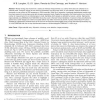Free Online Productivity Tools
i2Speak
i2Symbol
i2OCR
iTex2Img
iWeb2Print
iWeb2Shot
i2Type
iPdf2Split
iPdf2Merge
i2Bopomofo
i2Arabic
i2Style
i2Image
i2PDF
iLatex2Rtf
Sci2ools
TCBB
2010
2010
A Survey of Spatial Defects in Homo Sapiens Affymetrix GeneChips
Modern biology has moved from a science of individual measurements to a science where data are collected on an industrial scale. Foremost, among the new tools for biochemistry are chip arrays which, in one operation, measure hundreds of thousands or even millions of DNA sequences or RNA transcripts. While this is impressive, increasingly sophisticated analysis tools have been required to convert gene array data into gene expression levels. Despite the assumption that noise levels are low, since the number of measurements for an individual gene is small, identifying which signals are affected by noise is a priority. High-density oligonucleotide array (HDONAs) from NCBI GEO shows that, even in the best Human GeneChips 1/4 percent of data are affected by spatial noise. Earlier designs are noisier and spatial defects may affect more than 25 percent of probes. BioConductor R code is available as supplementary material which can be found on the Computer Society Digital Library at http://doi....
Gene Array Data | Gene Expression Levels | Society Digital Library | Software Engineering | TCBB 2010 |
| Added | 21 May 2011 |
| Updated | 21 May 2011 |
| Type | Journal |
| Year | 2010 |
| Where | TCBB |
| Authors | William B. Langdon, Graham J. G. Upton, Renata da Silva Camargo, Andrew P. Harrison |
Comments (0)

